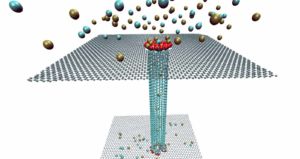Project overview
Abstract-Objectives
IONESCO aims to fabricate microsystems that can both measure and control, by means of electrical currents, the velocity and nature of the ions contained in the water and that pass through single wall carbon nanotubes (SWCNT) between two reservoirs a few micrometres apart. We believe that this objective is entirely achievable insofar as a number of remarkable phenomena have already been observed and can be attributed to the common properties of SWCNT: i) an exceptional geometric aspect ratio (the macroscopic equivalent would be a human hair several tens of metres long!), ii) a hydrophobic and almost faultless surface, and iii) electrical properties close to either metals or semiconductors.

IONESCO aims to fabricate microsystems that can both measure and control, by means of electrical currents, the velocity and nature of the ions contained in the water and that pass through single wall carbon nanotubes (SWCNT) between two reservoirs a few micrometres apart. We believe that this objective is entirely achievable insofar as a number of remarkable phenomena have already been observed and can be attributed to the common properties of SWCNT: i) an exceptional geometric aspect ratio (the macroscopic equivalent would be a human hair several tens of metres long!), ii) a hydrophobic and almost faultless surface, and iii) electrical properties close to either metals or semiconductors.
Issues
Thanks to the control of the ion transport in these nanotubes, it could be possible to manufacture systems capable of:
- filtering solutions containing several types of ions: the system therefore acts like a membrane;
- generating current when the two reservoirs contain electrolytes of different ionic concentration: the system acts as an energy plant (see recent the development of the so- called “blue” energy obtained from sea water)
- blocking, or not, as a function of the SWCNT surface potential the transport of ions, concomitant with a sudden change from a conductive to an insulating state: the system acts like a transistor;
- shedding light, by measuring the ionic current between the two reservoirs concurrentlywith the electrical potential at the nanotube surface, on the nature of the molecules that could pass through it: the system then acts as a sensor that can detect a single molecule.
Detailed description
It is a simple observation that electronic and biological systems do not use the same messengers for sending information: electrons in the former onesversussolvated ions (electrical signaling) or molecules (chemical signalling) in the latter ones. Coupling both systems therefore requires an interface for converting one signal into another, ideally with high speed and controllable gain. Unfortunately, the performances and functionalities of the current electro-ionic devices poorly compare with those of their electronic and biological counterparts,e.g.transistors and synapses respectively. For instance, the best ionic transistors (1,2) typically display switching frequencies of the order of Hz, on/off ratio around 100 and gain around 10, values which are several orders of magnitude lower than for electronic field-effect transistors (FETs) (3). Emerging fields such as iontronics, bioelectronics, or bioprotonics aim at developing a sophisticated control and sensing of the motion of ions and molecules to record and modulate biological processes, or to perform logic operations mimicking the functioning of the brain. Potential applications include the targeted delivery of neurotransmitters and drugs, miniaturized systems of biomonitoring, non-invasive perfusion of cells for controlling their culture or actuating neurons, biocompatible and low-consumption logic circuits, or brain-computer interfacing.
A main reason for the weak coupling between electrons and ions in electro-ionic devices is the electrostatic screening caused by the polar solvent,e.g.water, in which ions are dissolved. By analogy with electronic FETs, the best solution would be to reduce the distance between the gate electrode and the charge carriers: in other words, the ideal geometry for an ionic transistor would be a nanochannel with a diameter close to the size of solvated ions, and an electrically conducting surface whose electrical potential can be independently and strongly modulated (4). In addition, the channel should have an intrinsically high ionic conductance in the “ON” state and be highly selective for a specific type of ions (e.g.anions or cations) to suppress the conductance in the OFF state. 2D membranes (e.g.graphene nanopores) may appear as attractive candidates but their flat geometry causes a strong capacitive coupling with the bulk reservoirs, which is undesirable for a fast-operating ionic transistor.
In contrast, single-walled carbon nanotubes (SWCNTs) fulfil all the above criteria, which place them among the most promising materials for an advanced generation of electro-ionic devices. First, thanks to their diameter in the 0.7-2 nm range, SWCNTs offer the optimal electrostatic coupling between the channel wall and the translocating ions, together with minimal coupling with electrolyte reservoirs (5). Second, the transport of ions and fluids through SWCNTs is intrinsically fast thanks mainly to the very low friction on the smooth nanotube wall (6). Third, SWCNTs can be made extremely selective for a specific type of ion by controlling the nature and charge of the chemical functions at their ends (e.g.for cations by using COO–moieties) (7). Beside these established features, SWCNTs display unique electronic properties whose coupling with ion transport represents an appealing but essentially unexplored field of research. Precisely, depending on their chirality, SWCNTs can be either excellent conductors of electrons,i.e.metallic (M), or semiconducting (SC) materials extremely sensitive to their environment (8). Connecting metallic SWCNTs (M-SCWNTs) with electrical contacts therefore offers the prospect of actively controlling their surface charge and thereby the transport of ions through their inner channel. Such M-SWCNT-based ionic transistors are expected to display highly improved performances (gain, speed) due to the optimal electron-ion coupling in this configuration, but such devices have never been studied so far. Conversely, since SC-SWCNTs have a very high mobility and since all their atoms are located at the surface, they are the perfect nanomaterial for electronic sensors. The high sensitivity of SC-SWCNT-based FET sensors therefore offers the prospect of using them to sense the ionic species in their inner channel. In addition, because their surface charge can be actively controlled, SWCNT-based electro-ionic devices are also especially suited for studying new physical phenomena specific to the sub-continuum regime which have been theoretically predicted but never experimentally evidenced: i) Ionic Capillary Evaporation (ICE),i.e.stochastic transitions between two ionic phases of low (vapour-like) and high ionic density (liquid-like), as theoretically predicted by some of us (9), and ii) Ionic Coulomb Blockades (ICB,i.e.the build-up of ions inside the channel with capacitance impeding the flow of additional ions due to Coulomb repulsion (10).
Thus, the IONESCO project aims at exploring the potential of SWCNTs for 1) actively controlling and sensing the motion of ions by an unprecedently large coupling between ions (in the channel) and electrons in the SWCNT wall and 2) investigating the new transport phenomena specific to the subcontinuum regime. Third, we will investigate the ion species and surface charges in the inner channel of a SC-SWCNT by using it as a sensitive electronic FET sensor. This will allow us to measure the variations of inner electrolyte composition (cations, anions, H+, OH–) and the densities of permanent and regulated surface charges (which govern ion transport) as a function of the experimental conditions. On the fundamental side, we will look for i) stochastic fluctuations of ionic conductance at low surface charge to evidence ICE, and for ii) periodic oscillations of conductance with increasing surface charge, the unambiguous signature of IBC.
references:
(1)K. Tybrandt, K. C. Larsson, A. Richter-Dahlfors, M. Berggren, Ion bipolar junction transistors. Proc. Natl. Acad. Sci. . 107, 9929–9932 (2010);(2)R. Ren et al., Nanopore extended field-effect transistor for selective single-molecule biosensing. Nat. Commun. 8, 586 (2017);(3)K. Kim, J.-Y. Choi, T. Kim, S.-H. Cho, H.-J. Chung, A role for graphene in silicon-based semiconductor devices. Nature. 479, 338 (2011);(4)Lian, A. Gallegos, H. Liu, J. Wu, Non-scaling behavior of electroosmotic flow in voltage-gated nanopores. Phys. Chem. Chem. Phys. 19, 450–457 (2017);(5)P. Pang, J. He, J. H. Park, P. S. Krstic, S. Lindsay, Origin of Giant Ionic Currents in Carbon Nanotube Channels. ACS Nano. 5, 7277–7283 (2011);(6)E. Secchi et al., Massive radius-dependent flow slippage in single carbon nanotubes. Nature. 537, 210–213 (2016);(7)R. H. Tunuguntla et al., Enhanced water permeability and tunable ion selectivity in subnanometer carbon nanotube porins. Science. 357, 792–796 (2017);(8)L.-M. Peng, Z. Zhang, S. Wang, Carbon nanotube electronics: recent advances. Mater. Today. 17, 433–442 (2014);(9)S. Buyukdagli, M. Manghi, J. Palmeri, Ionic Capillary Evaporation in Weakly Charged Nanopores. Phys. Rev. Lett. 105, 158103 (2010);(10)M. Krems, M. Di Ventra, Ionic Coulomb blockade in nanopores. J. Phys. Condens. Matter. 25, 65101 (2013)
